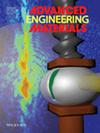RuAl thin film deposition by DC magnetron sputtering
IF 3.4
3区 材料科学
Q2 MATERIALS SCIENCE, MULTIDISCIPLINARY
引用次数: 0
Abstract
The intermetallic transition metal B2 structured aluminide RuAl is a candidate material for use in various applications, including microelectronics and structural materials under demanding conditions, for example as oxidation and corrosion resistant materials or microelectronics. In contrast to other B2 transition metal aluminides, which usually suffer from brittle material behavior at room temperature, RuAl exhibits comparatively good room temperature ductility, in combination with further promising properties. Therefore, RuAl thin films are attracting interest as potential protective and functional surface engineering materials. The synthesis of RuAl thin films by means of physical vapor deposition, especially magnetron sputtering, is however complex and utilizes co‐deposition and multilayer from elemental sputtering targets and subsequent annealing procedures. In this work we describe an alternative route towards single phase B2 structured RuAl thin films by non‐reactive DC magnetron sputter deposition at low substrate temperature from a powdermetallurgically manufactured Ru通过直流磁控溅射沉积 RuAl 薄膜
金属间过渡金属 B2 结构铝化物 RuAl 是一种可用于各种应用领域的候选材料,包括微电子和苛刻条件下的结构材料,例如用作抗氧化和抗腐蚀材料或微电子材料。其他 B2 过渡金属铝通常在室温下具有脆性材料的特性,而 RuAl 则具有相对较好的室温延展性,同时还具有其他良好的特性。因此,RuAl 薄膜作为潜在的保护性和功能性表面工程材料备受关注。然而,通过物理气相沉积法(尤其是磁控溅射法)合成 RuAl 薄膜非常复杂,需要利用元素溅射靶材的共沉积和多层沉积以及随后的退火程序。在这项研究中,我们介绍了另一种实现单相 B2 结构 RuAl 薄膜的方法,即在低基底温度下,从粉末冶金法制造的 Ru50Al50 复合靶材上进行非反应直流磁控溅射沉积。我们研究了沉积参数对 RuAl 薄膜的构成、微观结构和选定性能的影响。结果表明,尤其是氩气工艺气体压力对薄膜的组成和形态有重大影响。X 射线衍射和透射电子显微镜与选区电子衍射表明,薄膜是具有 B2 结构的单相 RuAl。本文受版权保护。
本文章由计算机程序翻译,如有差异,请以英文原文为准。
求助全文
约1分钟内获得全文
求助全文
来源期刊

Advanced Engineering Materials
工程技术-材料科学:综合
CiteScore
5.70
自引率
5.60%
发文量
544
审稿时长
1.7 months
期刊介绍:
Advanced Engineering Materials is the membership journal of three leading European Materials Societies
- German Materials Society/DGM,
- French Materials Society/SF2M,
- Swiss Materials Federation/SVMT.
 求助内容:
求助内容: 应助结果提醒方式:
应助结果提醒方式:


